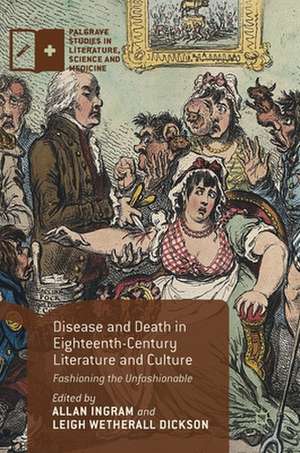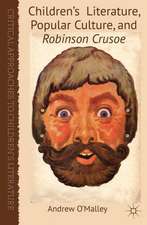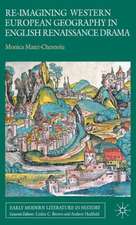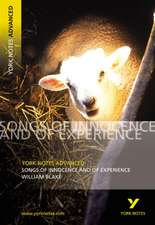Disease and Death in Eighteenth-Century Literature and Culture: Fashioning the Unfashionable: Palgrave Studies in Literature, Science and Medicine
Editat de Allan Ingram, Leigh Wetherall Dicksonen Limba Engleză Hardback – 2 mar 2017
These essays also look at ways in which diseases were fashioned into bearing cultural, moral, religious and even political meaning. Works of literature are used as evidence, but also medical writings, personal correspondence and diaries. Diseases or conditions subject to scrutiny include syphilis, male impotence, plague, smallpox and consumption. Death, finally, is looked at both in terms of writers constructing meanings within death and of the fashioning of posthumous reputation.
| Toate formatele și edițiile | Preț | Express |
|---|---|---|
| Paperback (1) | 694.69 lei 6-8 săpt. | |
| Palgrave Macmillan UK – 9 sep 2018 | 694.69 lei 6-8 săpt. | |
| Hardback (1) | 700.10 lei 6-8 săpt. | |
| Palgrave Macmillan UK – 2 mar 2017 | 700.10 lei 6-8 săpt. |
Din seria Palgrave Studies in Literature, Science and Medicine
- 20%
 Preț: 628.35 lei
Preț: 628.35 lei - 15%
 Preț: 699.12 lei
Preț: 699.12 lei - 15%
 Preț: 521.26 lei
Preț: 521.26 lei - 18%
 Preț: 780.68 lei
Preț: 780.68 lei - 15%
 Preț: 642.68 lei
Preț: 642.68 lei - 15%
 Preț: 588.37 lei
Preț: 588.37 lei - 15%
 Preț: 643.84 lei
Preț: 643.84 lei - 15%
 Preț: 698.80 lei
Preț: 698.80 lei - 15%
 Preț: 523.54 lei
Preț: 523.54 lei - 15%
 Preț: 499.12 lei
Preț: 499.12 lei - 15%
 Preț: 583.93 lei
Preț: 583.93 lei -
 Preț: 417.14 lei
Preț: 417.14 lei - 15%
 Preț: 691.91 lei
Preț: 691.91 lei - 15%
 Preț: 586.55 lei
Preț: 586.55 lei -
 Preț: 219.74 lei
Preț: 219.74 lei -
 Preț: 388.52 lei
Preț: 388.52 lei -
 Preț: 221.28 lei
Preț: 221.28 lei - 18%
 Preț: 783.98 lei
Preț: 783.98 lei -
 Preț: 389.11 lei
Preț: 389.11 lei - 18%
 Preț: 783.50 lei
Preț: 783.50 lei - 15%
 Preț: 527.15 lei
Preț: 527.15 lei - 15%
 Preț: 586.23 lei
Preț: 586.23 lei -
 Preț: 454.74 lei
Preț: 454.74 lei - 15%
 Preț: 582.95 lei
Preț: 582.95 lei - 15%
 Preț: 527.48 lei
Preț: 527.48 lei -
 Preț: 385.84 lei
Preț: 385.84 lei -
 Preț: 383.71 lei
Preț: 383.71 lei -
 Preț: 382.57 lei
Preț: 382.57 lei - 15%
 Preț: 501.55 lei
Preț: 501.55 lei - 15%
 Preț: 642.03 lei
Preț: 642.03 lei - 18%
 Preț: 737.43 lei
Preț: 737.43 lei - 18%
 Preț: 894.03 lei
Preț: 894.03 lei -
 Preț: 450.11 lei
Preț: 450.11 lei -
 Preț: 391.79 lei
Preț: 391.79 lei - 15%
 Preț: 640.55 lei
Preț: 640.55 lei - 15%
 Preț: 589.65 lei
Preț: 589.65 lei - 15%
 Preț: 499.59 lei
Preț: 499.59 lei
Preț: 700.10 lei
Preț vechi: 823.64 lei
-15% Nou
Puncte Express: 1050
Preț estimativ în valută:
133.98€ • 145.48$ • 112.54£
133.98€ • 145.48$ • 112.54£
Carte tipărită la comandă
Livrare economică 22 aprilie-06 mai
Preluare comenzi: 021 569.72.76
Specificații
ISBN-13: 9781137597175
ISBN-10: 1137597178
Pagini: 264
Ilustrații: VIII, 290 p.
Dimensiuni: 148 x 210 x 18 mm
Greutate: 0.51 kg
Ediția:1st ed. 2016
Editura: Palgrave Macmillan UK
Colecția Palgrave Macmillan
Seria Palgrave Studies in Literature, Science and Medicine
Locul publicării:London, United Kingdom
ISBN-10: 1137597178
Pagini: 264
Ilustrații: VIII, 290 p.
Dimensiuni: 148 x 210 x 18 mm
Greutate: 0.51 kg
Ediția:1st ed. 2016
Editura: Palgrave Macmillan UK
Colecția Palgrave Macmillan
Seria Palgrave Studies in Literature, Science and Medicine
Locul publicării:London, United Kingdom
Cuprins
Introduction: Fashioning the Unfashionable; Allan Ingram and Leigh Wetherall Dickson.- PART I: ENNUI.- 1. ‘[F]ictitious [D]istress’ or Veritable Woe?: The Problem of Eighteenth-Century Ennui; Heather Meek.- 2. ‘What is fashionably termed ennui’: Maria Edgeworth Represents the Clinically Bored; Jane Taylor.- PART II: DISEASE OF SEXUALITY.- 3. Dean Swift on the Great Pox: or, The Satirist as Physician; Hermann J. Real.- 4. The à la Mode Disease: Syphilis and Temporality; Emily Cock.- 5. Of Fribblers and Fumblers: Fashioning Male Impotence in the Long Eighteenth Century; Kirsten Juhas.- PART III: INFECTIOUS DISEASES.- 6. Fashioning Unfashionable Plague: Daniel Defoe’s Journal of the Plague Year (1722); Hélène Dachez.- 7. How Small is Small? Small Pox, Large Presence; Allan Ingram.- 8. ‘Halfe Dead: and rotten at the Coare: my Lord!’: Fashionable and Unfashionable Consumption, from Early Modern to Enlightenment; Clark Lawlor.- PART IV: FASHIONING DEATH.- 9. Death by Inoculation: The Fashioning of Mortality in Eighteenth-Century Smallpox Pamphlets; Kelly McGuire.- 10. Fashion Victim: Suicide, Sociability and High Society in Georgiana Cavendish’s The Sylph; Leigh Wetherall Dickson.- 11. ‘Alas, poor Yorick!’: Jonathan Swift, Madness, and Fashionable Science; Helen Deutsch.- Bibliography.- Index.-
Recenzii
“Disease and Death has the welcoming feel of a book designed to open new areas of enquiry and invite further research; one can only hope such interests will prove infectious.” (Noelle Dückmann Gallagher, Eighteenth-Century Fiction, Vol. 33 (1), 2020)
“This collection of essays proves the continued fruitfulness of exploring the intersections of medicine and literature in eighteenth-century British society, by viewing disease from the perspective of what is ‘fashionable’ and ‘unfashionable’. … Disease and Death in Eighteenth-Century Literature and Culture traces the intertwined social and narrative shifts in attitude towards these diseases over the long eighteenth century.” (Margaret S. Yoon, The Review of English Studies, April, 2018)
Notă biografică
Allan Ingram is Emeritus Professor of English at the University of Northumbria, UK. He has published widely on eighteenth-century writing, with a particular interest in the relations between literature, medicine, and madness. His works in this field include The Madhouse of Language (1991) and Cultural Constructions of Madness (2005). Between 2006 and 2009 he was Director of the Leverhulme Trust project ‘Before Depression’, and was a Co-Director of the Leverhulme project, ‘Fashionable Diseases’, of which this volume is one outcome. He has edited Gulliver’s Travels (2012) and was co-editor of a four-volume set of source material, Depression and Melancholy 1660-1800 (2012). Most recently he co-edited a set of essays, Voice and Context in Eighteenth-Century Poetry (2015).
Leigh Wetherall Dickson is Senior Lecturer in eighteenth and nineteenth-century literature at Northumbria University, UK. She began her career there as a post-doctoral Research Associate on the Leverhulme-funded ‘Before Depression 1660-1800’ project. She has written and published extensively upon the experience of presumed mental disease, and was the co-general editor and volume editor for Depression and Melancholy 1600–1800 (2012). She is now one of the directors of ‘Fashionable Diseases: Medicine, Literature and Culture, ca. 1660–1832’, also funded by the Leverhulme Trust for three years. Her current research focusses upon the relationship between fashion, fame, and illness in the long eighteenth century, and is particularly interested in how the pursuit of fame was viewed as a type of contagious disease.
Leigh Wetherall Dickson is Senior Lecturer in eighteenth and nineteenth-century literature at Northumbria University, UK. She began her career there as a post-doctoral Research Associate on the Leverhulme-funded ‘Before Depression 1660-1800’ project. She has written and published extensively upon the experience of presumed mental disease, and was the co-general editor and volume editor for Depression and Melancholy 1600–1800 (2012). She is now one of the directors of ‘Fashionable Diseases: Medicine, Literature and Culture, ca. 1660–1832’, also funded by the Leverhulme Trust for three years. Her current research focusses upon the relationship between fashion, fame, and illness in the long eighteenth century, and is particularly interested in how the pursuit of fame was viewed as a type of contagious disease.
Caracteristici
Contributes to the growing body of work in Medical Humanities Brings together contributions from a range of experts in the field of literature, science and medicine Looks at medical writings, personal correspondence and diaries as well as literature

















